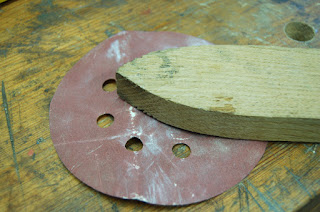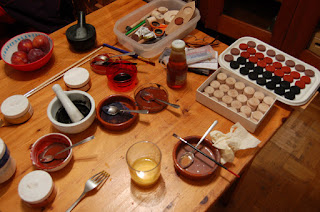The game board and the seven sided dice for the medieval Game of the Four Seasons, called the World being ready, the only remaining pieces to be made were the gaming counters. I will first provide some medieval examples of gaming counters for 'tables' (backgammon and tric trac like games) and then continue with the making and decoration process of the gaming pieces.
Medieval gaming counters
Medieval gaming counters or tablemen have been commonly encountered during archaeological excavations, though less than dice. This is probably due to the fact that they are not always easily recognisable. Medieval gaming counters were made of bone, ivory, leather, stone, ceramics, metal (lead, copper alloy) or wood and vary in size, thickness, and decoration. There are very plain gaming counters, but also pieces that are elaborately carved - each one with a different image.
Left: Three medieval bone gaming pieces found in Friesland, the Netherlands (photo courtesy Rijksmuseum voor Oudheden, Leiden, the Netherlands). Sizes 0.28 x 1.67 cm, 0.3 x 2.04 cm, and 0.45 x 2.14 cm. The gaming counters are decorated with concentric circles. Right: Six bone and antler playing pieces of a set of thirty from a backgammon game found at Gloucester Castle, UK. All pieces are decorated with different designs. 44 mm diameter, 7 mm thickness. Dated between 1090-1120.








'And because as we said above in the first season, spring, all things grow and men are refreshed and the trees and plants turn green the reason why air is its element is clearer than for any other season; therefore they made this season green. And the summer which is hotter and drier than the other seasons they made it like fire, which is of this nature. And therefore they made this season red for it element which also is. The autumn is dry and cold because its element is earth; it is more temperate than summer because it tends more toward cold than heat. The things that burn in summer, are born and refreshed in this season. And because its element is earth, its nature coldness and dryness therefore they made this season’s colour black. Winter they gave the element water which is cold and wet because in that season there are great cold, ice, snow, and rains. And because its element is water they made its colour white.'
I have painted the gaming pieces with egg tempera paint according to the recipe by Kathy Storm found on her blog Medieval arts and crafts. This consists of two parts of dry white wine and one part egg yolk. The pigments are added to this to form the tempera paint. Not all pigments used produced opaque paints (e.g. green and white), but adding more pigments decreased the ease of painting considerably. Therefore most gaming counters had several layers of paint. I used pigments of the Dutch paint mill "De Kat" that presumably also were available during the Middle ages. These were:
I also painted gaming counters for an astronomical tables version for seven persons that is found as well in the book of games by Alfonso X. The counters for that game are:
I did have a wooden box for storing the counters, but eventually a box like the one shown below might be more appropriate ... The next post will continue with playing of the Game of the Four Seasons, called the World.
Left: Three medieval bone gaming pieces found in Friesland, the Netherlands (photo courtesy Rijksmuseum voor Oudheden, Leiden, the Netherlands). Sizes 0.28 x 1.67 cm, 0.3 x 2.04 cm, and 0.45 x 2.14 cm. The gaming counters are decorated with concentric circles. Right: Six bone and antler playing pieces of a set of thirty from a backgammon game found at Gloucester Castle, UK. All pieces are decorated with different designs. 44 mm diameter, 7 mm thickness. Dated between 1090-1120.
Left: Leather gaming counters made from a shoe sole. Right: Four decorated wooden gaming counters. Both are excavated from 'Het Steen', a 14th century town prison at the town square in Mechelen, Belgium (details from L. Troubleyn et al., 2009. Journal of Archeology in the Low Countries 2).
Left: A cast copper alloy gaming piece dating from the 13-14th century. The upper face of the object is decorated in moulded relief with an advancing
stag. The rear of the object is undecorated and flat. Thickness 8.02 mm, weight 80.2 g and 41.06 mm diameter. Photo from the finds database of the British Museum. Right: Four early medieval tablemen of a set of 24 round stone discs found at Whithorn, UK. A number of gaming boards was also found at the site. The gaming pieces measure between 2.3 and 3 cm diameter. One tablemen with a
cross scratched on one face may be to represent a special piece,
such as the king in a game of hnefatafl (King's Board). Photo from the Future museum UK.


Left: 11th century wooden backgammon pieces from Colletire, France. Right: Trictrac board and gaming pieces found in an Augustinerkloster in Freiburg, Germany. The board is likely made after 1278.
14th century wooden tric-trac board and gaming piece excavated at the Breestraat, Leiden, the Netherlands. Rijksmuseum van Oudheden, Leiden, the Netherlands. The board fragment measures 26.5 x 12.5 cm and is inlaid with different types of wood. The tableman has an incised circle decoration and a diameter of 2.7 cm.
Making the gaming counters
Two medieval wooden gaming counters from London excavations. Left: Turned boxwood counter, ca. 36 mm with central dots and grooves around the edge. Right: Apple wood, 37 mm with concentric circles and groove around the edge. Both gaming counters have black staining, indicating these were black painted tablemen. From the book: The medieval household, daily living c. 1150-1450. Medieval finds from excavations in London 6 by G. Egan.
The gaming counter from London (UK) served as (decorative) model for our gaming counters. I have made our gaming pieces from beech. The first step was to transform the square pieces of wood into a round sticks by simple turning on a lathe. Then the sticks were cut by bandsaw into the proto gaming pieces. A block clamped on the saw-table was used to ensure that the gaming pieces were of equal thickness. As I wanted to add some circular decoration on the counters, an additional round of turning was needed. For this a special jig was made in which the proto counters were clamped tight and that allowed the front and backside to be decorated. The edges of the gaming counters were also slightly rounded and each counter was sanded manually.

Left: Making the beech sticks. First the square was planed octagonal (see marks on the square piece of wood) for ease of turning and then turned to a diameter of 2.8 cm. Several sticks can be seen in the background. Right: Cutting gaming pieces with a band saw. A block of wood is clamped onto the table, to produce gaming pieces with an equal thickness of 8 mm.


Left: Another view of the bandsaw, showing how the equal thickness is achieved. Right: The proto gaming pieces. Four sets of twelve gaming counters are needed for the game of the Four Seasons.


Left: The special plywood jig for turning screwed on the faceplate. The hole for the gaming counter was first turned out of the plywood block. The hole was slightly tapered to have the gaming counter secured enough for turning. When the proto gaming piece happened to be too small it was additionally fixed with double adhesive tape. Right: A slot was made in the jig to be able to extract the finished decorated gaming counter with the help of a small screwdriver.
Right: The bottom of a jig used for sanding the gaming counters. A shallow hole was made in a piece of wood to hold the gaming piece. Right: The jig offers a better grip when sanding.
Right: The bottom of a jig used for sanding the gaming counters. A shallow hole was made in a piece of wood to hold the gaming piece. Right: The jig offers a better grip when sanding.
A heap of finished unpainted gaming counters.
Three unpainted gaming counters decorated with concentric rings. The edges are rounded.
Painting the gaming counters
The Libro de los Juegos of Alfonso X the Wise describes the colours of the four seasons for four-season chess and the tables game of the four seasons called the world:'And because as we said above in the first season, spring, all things grow and men are refreshed and the trees and plants turn green the reason why air is its element is clearer than for any other season; therefore they made this season green. And the summer which is hotter and drier than the other seasons they made it like fire, which is of this nature. And therefore they made this season red for it element which also is. The autumn is dry and cold because its element is earth; it is more temperate than summer because it tends more toward cold than heat. The things that burn in summer, are born and refreshed in this season. And because its element is earth, its nature coldness and dryness therefore they made this season’s colour black. Winter they gave the element water which is cold and wet because in that season there are great cold, ice, snow, and rains. And because its element is water they made its colour white.'
Left: painting the black gaming pieces. One side can be painted at a time, a quarter of an hour later the other side can be painted. Right: various paints and the basic egg tempera in a glass. on the far right the finished red, black and purple pieces can be seen, as well as the box with unpainted tablemen.
I have painted the gaming pieces with egg tempera paint according to the recipe by Kathy Storm found on her blog Medieval arts and crafts. This consists of two parts of dry white wine and one part egg yolk. The pigments are added to this to form the tempera paint. Not all pigments used produced opaque paints (e.g. green and white), but adding more pigments decreased the ease of painting considerably. Therefore most gaming counters had several layers of paint. I used pigments of the Dutch paint mill "De Kat" that presumably also were available during the Middle ages. These were:
- red- summer - Venetian red
- black - autumn - bone black
- white - winter - double washed white chalk
- green - spring - Italian green earth
The four colours for the game of the four seasons called the world.
I also painted gaming counters for an astronomical tables version for seven persons that is found as well in the book of games by Alfonso X. The counters for that game are:
- red - Mars - Venetian red
- black - Saturn - bone black
- white - Moon - double washed white chalk
- green - Jupiter - Italian green earth
- yellow - Sun - yellow ochre
- purple - Venus - mix of blue chalk, Venetian red and white chalk
- many different colours - Mercury - black, red and yellow circles
The coloured gaming counters for the astronomical tables: black, yellow, red, purple,
white, green and many different colours.
The completed Game of the Four Seasons, called the World as depicted in the Libro de los Juegos by Alfonso X,
folio 89v.
folio 89v.
I did have a wooden box for storing the counters, but eventually a box like the one shown below might be more appropriate ... The next post will continue with playing of the Game of the Four Seasons, called the World.
Painted wooden box for game pieces, dated ca. 1300 and made in Germany. Sizes 7.9 x 26.4 x 9.2 cm.
Metropolitan Museum of Art, New York, USA.
Metropolitan Museum of Art, New York, USA.




















































